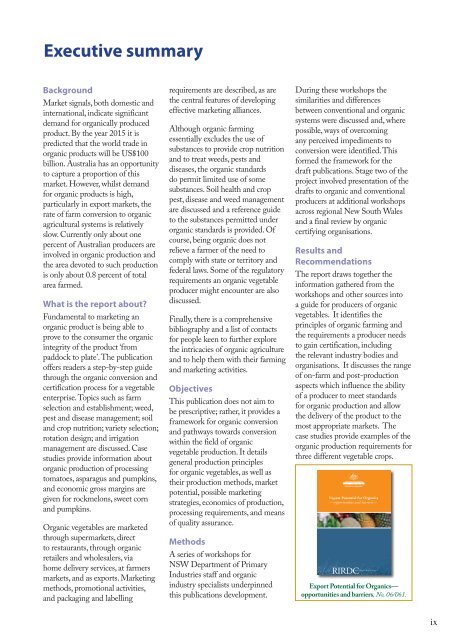4. Organic vegetable production
4. Organic vegetable production
4. Organic vegetable production
You also want an ePaper? Increase the reach of your titles
YUMPU automatically turns print PDFs into web optimized ePapers that Google loves.
Executive summary<br />
Background<br />
Market signals, both domestic and<br />
international, indicate significant<br />
demand for organically produced<br />
product. By the year 2015 it is<br />
predicted that the world trade in<br />
organic products will be US$100<br />
billion. Australia has an opportunity<br />
to capture a proportion of this<br />
market. However, whilst demand<br />
for organic products is high,<br />
particularly in export markets, the<br />
rate of farm conversion to organic<br />
agricultural systems is relatively<br />
slow. Currently only about one<br />
percent of Australian producers are<br />
involved in organic <strong>production</strong> and<br />
the area devoted to such <strong>production</strong><br />
is only about 0.8 percent of total<br />
area farmed.<br />
What is the report about?<br />
Fundamental to marketing an<br />
organic product is being able to<br />
prove to the consumer the organic<br />
integrity of the product ‘from<br />
paddock to plate’. The publication<br />
offers readers a step-by-step guide<br />
through the organic conversion and<br />
certification process for a <strong>vegetable</strong><br />
enterprise. Topics such as farm<br />
selection and establishment; weed,<br />
pest and disease management; soil<br />
and crop nutrition; variety selection;<br />
rotation design; and irrigation<br />
management are discussed. Case<br />
studies provide information about<br />
organic <strong>production</strong> of processing<br />
tomatoes, asparagus and pumpkins,<br />
and economic gross margins are<br />
given for rockmelons, sweet corn<br />
and pumpkins.<br />
<strong>Organic</strong> <strong>vegetable</strong>s are marketed<br />
through supermarkets, direct<br />
to restaurants, through organic<br />
retailers and wholesalers, via<br />
home delivery services, at farmers<br />
markets, and as exports. Marketing<br />
methods, promotional activities,<br />
and packaging and labelling<br />
requirements are described, as are<br />
the central features of developing<br />
effective marketing alliances.<br />
Although organic farming<br />
essentially excludes the use of<br />
substances to provide crop nutrition<br />
and to treat weeds, pests and<br />
diseases, the organic standards<br />
do permit limited use of some<br />
substances. Soil health and crop<br />
pest, disease and weed management<br />
are discussed and a reference guide<br />
to the substances permitted under<br />
organic standards is provided. Of<br />
course, being organic does not<br />
relieve a farmer of the need to<br />
comply with state or territory and<br />
federal laws. Some of the regulatory<br />
requirements an organic <strong>vegetable</strong><br />
producer might encounter are also<br />
discussed.<br />
Finally, there is a comprehensive<br />
bibliography and a list of contacts<br />
for people keen to further explore<br />
the intricacies of organic agriculture<br />
and to help them with their farming<br />
and marketing activities.<br />
Objectives<br />
This publication does not aim to<br />
be prescriptive; rather, it provides a<br />
framework for organic conversion<br />
and pathways towards conversion<br />
within the field of organic<br />
<strong>vegetable</strong> <strong>production</strong>. It details<br />
general <strong>production</strong> principles<br />
for organic <strong>vegetable</strong>s, as well as<br />
their <strong>production</strong> methods, market<br />
potential, possible marketing<br />
strategies, economics of <strong>production</strong>,<br />
processing requirements, and means<br />
of quality assurance.<br />
Methods<br />
A series of workshops for<br />
NSW Department of Primary<br />
Industries staff and organic<br />
industry specialists underpinned<br />
this publications development.<br />
During these workshops the<br />
similarities and differences<br />
between conventional and organic<br />
systems were discussed and, where<br />
possible, ways of overcoming<br />
any perceived impediments to<br />
conversion were identified. This<br />
formed the framework for the<br />
draft publications. Stage two of the<br />
project involved presentation of the<br />
drafts to organic and conventional<br />
producers at additional workshops<br />
across regional New South Wales<br />
and a final review by organic<br />
certifying organisations.<br />
Results and<br />
Recommendations<br />
The report draws together the<br />
information gathered from the<br />
workshops and other sources into<br />
a guide for producers of organic<br />
<strong>vegetable</strong>s. It identifies the<br />
principles of organic farming and<br />
the requirements a producer needs<br />
to gain certification, including<br />
the relevant industry bodies and<br />
organisations. It discusses the range<br />
of on-farm and post-<strong>production</strong><br />
aspects which influence the ability<br />
of a producer to meet standards<br />
for organic <strong>production</strong> and allow<br />
the delivery of the product to the<br />
most appropriate markets. The<br />
case studies provide examples of the<br />
organic <strong>production</strong> requirements for<br />
three different <strong>vegetable</strong> crops.<br />
Export Potential for <strong>Organic</strong>s<br />
—opportunities and barriers—<br />
RIRDCInnovation for rural Australia<br />
Export Potential for <strong>Organic</strong>s—<br />
opportunities and barriers, No. 06/061.<br />
ix

















